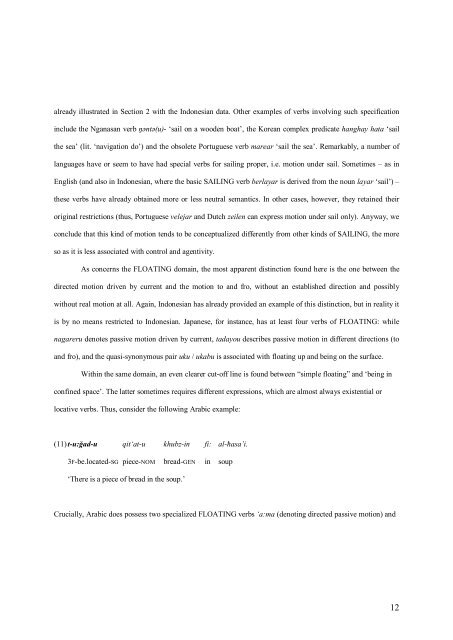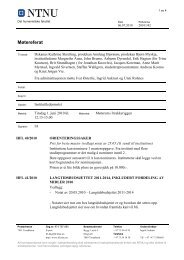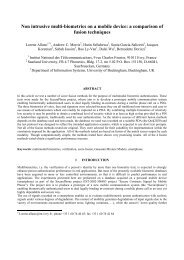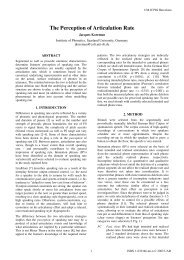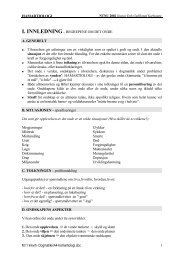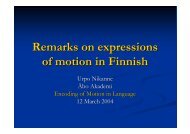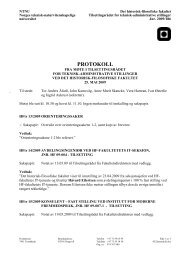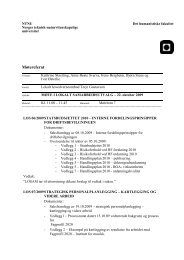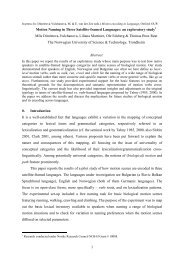Domains of aqua-motion: a case study in lexical typology Yury A ...
Domains of aqua-motion: a case study in lexical typology Yury A ...
Domains of aqua-motion: a case study in lexical typology Yury A ...
You also want an ePaper? Increase the reach of your titles
YUMPU automatically turns print PDFs into web optimized ePapers that Google loves.
already illustrated <strong>in</strong> Section 2 with the Indonesian data. Other examples <strong>of</strong> verbs <strong>in</strong>volv<strong>in</strong>g such specification<br />
<strong>in</strong>clude the Nganasan verb ŋəntə(u)- ‘sail on a wooden boat’, the Korean complex predicate hanghay hata ‘sail<br />
the sea’ (lit. ‘navigation do’) and the obsolete Portuguese verb marear ‘sail the sea’. Remarkably, a number <strong>of</strong><br />
languages have or seem to have had special verbs for sail<strong>in</strong>g proper, i.e. <strong>motion</strong> under sail. Sometimes – as <strong>in</strong><br />
English (and also <strong>in</strong> Indonesian, where the basic SAILING verb berlayar is derived from the noun layar ‘sail’) –<br />
these verbs have already obta<strong>in</strong>ed more or less neutral semantics. In other <strong>case</strong>s, however, they reta<strong>in</strong>ed their<br />
orig<strong>in</strong>al restrictions (thus, Portuguese velejar and Dutch zeilen can express <strong>motion</strong> under sail only). Anyway, we<br />
conclude that this k<strong>in</strong>d <strong>of</strong> <strong>motion</strong> tends to be conceptualized differently from other k<strong>in</strong>ds <strong>of</strong> SAILING, the more<br />
so as it is less associated with control and agentivity.<br />
As concerns the FLOATING doma<strong>in</strong>, the most apparent dist<strong>in</strong>ction found here is the one between the<br />
directed <strong>motion</strong> driven by current and the <strong>motion</strong> to and fro, without an established direction and possibly<br />
without real <strong>motion</strong> at all. Aga<strong>in</strong>, Indonesian has already provided an example <strong>of</strong> this dist<strong>in</strong>ction, but <strong>in</strong> reality it<br />
is by no means restricted to Indonesian. Japanese, for <strong>in</strong>stance, has at least four verbs <strong>of</strong> FLOATING: while<br />
nagareru denotes passive <strong>motion</strong> driven by current, tadayou describes passive <strong>motion</strong> <strong>in</strong> different directions (to<br />
and fro), and the quasi-synonymous pair uku / ukabu is associated with float<strong>in</strong>g up and be<strong>in</strong>g on the surface.<br />
With<strong>in</strong> the same doma<strong>in</strong>, an even clearer cut-<strong>of</strong>f l<strong>in</strong>e is found between “simple float<strong>in</strong>g” and ‘be<strong>in</strong>g <strong>in</strong><br />
conf<strong>in</strong>ed space’. The latter sometimes requires different expressions, which are almost always existential or<br />
locative verbs. Thus, consider the follow<strong>in</strong>g Arabic example:<br />
(11) t-u:ğad-u qit‘at-u khubz-<strong>in</strong> fi: al-ħasa’i.<br />
3F-be.located-SG piece-NOM bread-GEN <strong>in</strong> soup<br />
‘There is a piece <strong>of</strong> bread <strong>in</strong> the soup.’<br />
Crucially, Arabic does possess two specialized FLOATING verbs ‘a:ma (denot<strong>in</strong>g directed passive <strong>motion</strong>) and<br />
12


